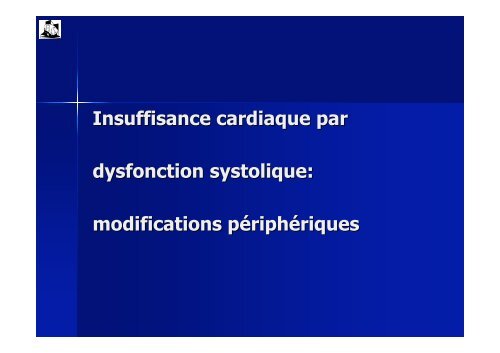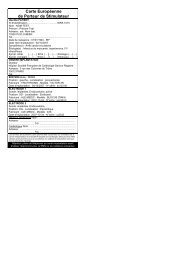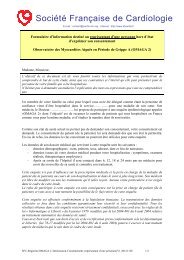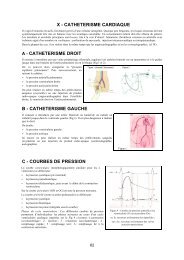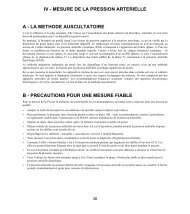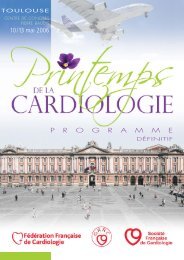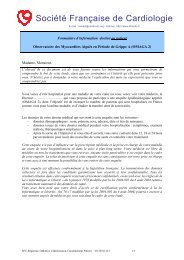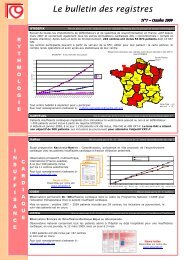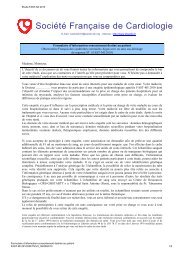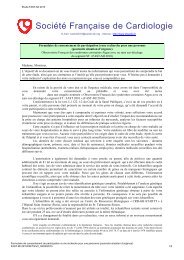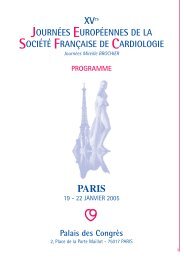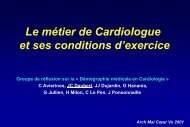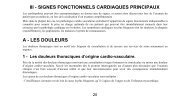Physiopathologie de l'insuffisance cardiaque
Physiopathologie de l'insuffisance cardiaque
Physiopathologie de l'insuffisance cardiaque
Create successful ePaper yourself
Turn your PDF publications into a flip-book with our unique Google optimized e-Paper software.
Insuffisance <strong>cardiaque</strong> par<br />
dysfonction systolique:<br />
modifications périphériques
Dissociation FEVG VO 2<br />
VeHF 1 VeHF 2<br />
Circulation, 1993;87:VI-5
Maillons <strong>de</strong> la chaîne<br />
VO2 = Qc (CaO2 - CvO2)<br />
– Qc: facteur <strong>cardiaque</strong><br />
– CaO2: facteur respiratoire<br />
– CvO2: facteur périphérique
Maillons <strong>de</strong> la chaîne<br />
O2<br />
O2<br />
ENERGIE<br />
O2
Coeur ?<br />
dobutamine au<br />
pic <strong>de</strong> l'effort<br />
et VO2<br />
Maskin et coll Am J Cardiol 1983;51:177-82
Respiratoire ?<br />
<br />
<br />
<br />
Modifications <strong>de</strong>s paramètres <strong>de</strong> diffusion <strong>de</strong><br />
l'O2<br />
– syndrome obstructif<br />
– Pas <strong>de</strong> désaturation du sang artériel à l'effort:<br />
Modification <strong>de</strong>s paramètres <strong>de</strong> ventilation<br />
diminution <strong>de</strong> la capacité vitale<br />
augmentation <strong>de</strong> l'espace mort<br />
augmentation <strong>de</strong> la ventilation pour une même VO2<br />
– Réserve ventilatoire préservée ou augmentée<br />
Si un facteur respiratoire est limitant, c'est<br />
indirectement<br />
inconfort créé par le problème pulmonaire qui limite<br />
l'exercice<br />
bénéfice <strong>de</strong> l'entraînement respiratoire ?
Sujets normaux<br />
normaux Bergh U. et<br />
coll J Appl Physiol 1976;41:191<br />
10<br />
% augmentation VO2 max<br />
avec les bras vs jambes seules<br />
0<br />
-10<br />
-20<br />
-30<br />
10% 20% 30% 40% 100% optimal<br />
% travail total avec les bras
Population<br />
19 insuffisants <strong>cardiaque</strong>s<br />
– 16 hommes, , 3 femmes<br />
– âge moyen 58 ans (47 à 67 ans)<br />
– fraction d'éjectionopathies primitives<br />
– Sans artérite <strong>de</strong>s membres inférieurs<br />
7 sujets normaux<br />
– sé<strong>de</strong>ntaires
Métho<strong>de</strong>s<br />
charge (kpm)<br />
ajout <strong>de</strong>s bras (Qr=1)<br />
temps (mn)
Résultats
Modifications en<br />
microscopie <strong>de</strong>s cellules<br />
musculaires<br />
squelettiques<br />
Drexler et al<br />
Circulation<br />
1992;85:1751
Modifications du<br />
métabolisme <strong>de</strong>s cellules<br />
musculaires squelettiques<br />
au cours <strong>de</strong> l'effort<br />
Massie et coll. Circulation 1987
Decreased skeletal<br />
muscle mass<br />
mid calf magnetic resonance imaging<br />
Congestive heart failure<br />
Normal<br />
Mancini et al. Circulation 1992;1364-1373
Circulation 2006;114:126<br />
<br />
<br />
<br />
<br />
Cachexia >7.5% body weight loss compared to<br />
prior to first event (AMI…)<br />
body composition dual-energy x -ray absoptiometry<br />
modified bruce<br />
ergoreflex test:<br />
– 50% mas load finger flexion repeated until exhaustion or<br />
cycling at 60% load for 5 min<br />
– i<strong>de</strong>m + venous and arterial occlusion before end of<br />
exercise for 3 minutes<br />
– 107 patients, 24 controls
Circulation 2006;114:126<br />
contribution refex sur<br />
ventil > chez cachectic
Circulation 2006;114:126<br />
contribution refex sur<br />
ventil > chez cachectic
6<br />
Femoral Vein O2<br />
content (ml/100ml)<br />
4<br />
2<br />
n=58<br />
r=0.72<br />
p
Maillons <strong>de</strong> la chaîne<br />
O2<br />
O2<br />
ENERGIE<br />
O2
Débit maximal<br />
sujets normaux<br />
insuffisants <strong>cardiaque</strong>s<br />
AVANT-BRAS<br />
JAMBE
Débit max et VO 2<br />
25<br />
25<br />
y = 0.3x + 7<br />
r = 0.58<br />
n = 46<br />
p < 0.0001<br />
15<br />
15<br />
5<br />
0<br />
20<br />
40 60<br />
Débit maximal<br />
80<br />
5<br />
5<br />
15<br />
25<br />
Débit maximal<br />
35<br />
(ml/min.100ml)<br />
(ml/min.100ml)<br />
AVANT-BRAS<br />
JAMBE
Réponse à la NTG<br />
Nx (n=6)<br />
IC (n=19)<br />
NTG 10-7M NTG 10-7 NTG 10-5<br />
n=6 n=19 n=10<br />
Contrôle 10,7 ± 2,4 7,4 ± 4,7 5,7 ± 4,1<br />
NTG 21,7 ± 3,6 10,8 ± 4,6 28,7 ± 12
L'entraînement physique ↑<br />
la réponse endothéliale humaine<br />
Hornig Circulation 1996;93:210-4<br />
12 insuffisants<br />
<strong>cardiaque</strong>s et 7 normaux<br />
↑ Ø artère radiale après<br />
occlusion avant-bras 8<br />
min<br />
avec et sans L-NMMA<br />
(bloque<br />
formation NO,<br />
65% <strong>de</strong> la réponse à<br />
l'acetylcholine)<br />
Entraînement: : 4<br />
semaines <strong>de</strong> "handgrip"
Diminution du débit <strong>de</strong><br />
l'artère caroti<strong>de</strong> commune<br />
par occlusion <strong>de</strong>l'artère<br />
caroti<strong>de</strong> externe<br />
Avec et sans endothelium<br />
<br />
Pas <strong>de</strong> diminution du<br />
diamètre <strong>de</strong>s artères dans<br />
<strong>l'insuffisance</strong> <strong>cardiaque</strong>
Limitation centrale ou<br />
périphérique ?<br />
Entrainement physique, IEC aux longs cours…<br />
l/min<br />
Dobutamine, IEC aigu…<br />
débit <strong>cardiaque</strong> maximal (Qc)<br />
débit maximal admis en périphérie (Ql)<br />
VO2 maximale<br />
Limitation périphérique<br />
Qc > Ql<br />
Limitation centrale<br />
Qc < Ql<br />
aggravation<br />
amélioration
Chronic ACEI and peak VO2<br />
Mancini et al. J Am Coll Cardiol 1987;10:845-50<br />
Drexler et al Circulation 1989;79:491
Progressivement…<br />
J Am Coll Cardiol 1983;2:755
Effets aigus ne permettent pas <strong>de</strong><br />
prévoir les bénéfices à long terme
Chronic ACEI: role of the<br />
periphery<br />
Increase in VO2<br />
(%)<br />
L after ACEI<br />
DVO 2 10%<br />
Effect of arm cranking on peak<br />
VO 2
emo<strong>de</strong>lling
Effet <strong>cardiaque</strong> <strong>de</strong>s<br />
IEC:<br />
limite dilatation VG
NZ (taille VG)
MIRACLE Circ 2003;107:1985<br />
QRS>130 ms, LVEDD>55 mm, LVEF
FACTEUR INITIAL<br />
Surcharge volume<br />
IM, IAo<br />
Surcharge pression<br />
RA,HTA<br />
Perte myocytes<br />
IDM, Myocardite, Age<br />
EFFETS VENTRICULAIRES<br />
"REMODELING"<br />
Hypertrophie<br />
Dilatation<br />
IM fonctionnelle<br />
s diastole<br />
† myocytes<br />
Elongation<br />
"Slippage"<br />
Déficit énergétique<br />
EFFETS PERIPHERIQUES<br />
"INSUFFISANCE CARDIAQUE"<br />
¯ fonction systolique<br />
postcharge<br />
Fraction d'éjection VG<br />
(%)<br />
70<br />
60<br />
50<br />
40<br />
30<br />
20<br />
10<br />
0<br />
>50<br />
30<br />
FE VG<br />
ASYMPTOMATIQUE I II III IV<br />
28<br />
VO2<br />
20<br />
¯ chronique du flux<br />
Dysfonction endothéliale<br />
24<br />
15<br />
10<br />
30<br />
20<br />
10<br />
0<br />
VO 2<br />
(ml/kg/min)
Remo<strong>de</strong>lage: Pc<br />
Circulation. 2003;108:833
Remo<strong>de</strong>lage après IDM
99 first infarction<br />
Gaudron P, Circulation 1993;87:755<br />
Dilation: more anterior, larger, TIMI lower at 3-5 weeks<br />
thrombolysis 60% dans les 3 groupes
Conclusion<br />
Insuffisance <strong>cardiaque</strong><br />
– maladie générale<br />
cœur: remo<strong>de</strong>lage<br />
périphérie: limitation fonctionnelle<br />
– valeurs pronostiques indépendantes<br />
– cibles pour le traitement


